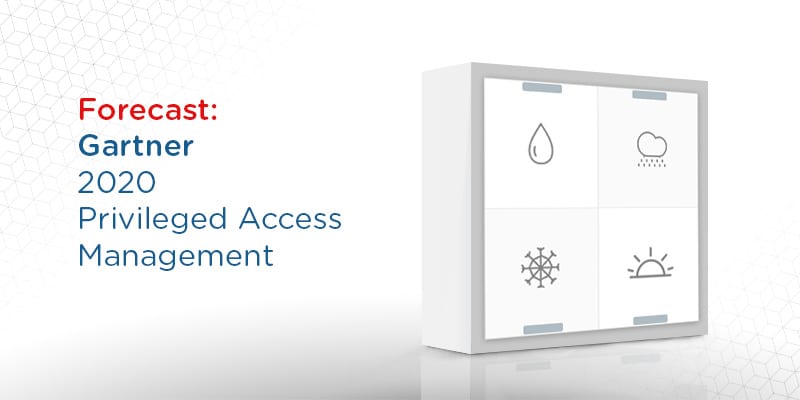Forecast: Gartner’s 2020 Privileged Access Management Magic Quadrant


Technology experts around the world impatiently wait for the release of the Gartner 2020 Privileged Access Management Magic Quadrant report. The research giant published the first-ever iteration of the Privileged Access Management Magic Quadrant in 2018. After a year’s absence, evidence suggests Gartner plans to release the 2020 report in May.
Thanks to their proprietary research methodology, Gartner’s annual marketplace analyses generate a level of buzz in the tech world only matched by Apple’s keynote speeches. In fact, many experts consider the Magic Quadrant the premier Gartner report in each cybersecurity technology marketplace. Often, enterprise cybersecurity professionals and administrators use Gartner’s findings as a foundation for their research and yearly purchasing decisions.
However, professionals can’t merely wait patiently for the 2020 Privileged Access Management Magic Quadrant report. Every day, hackers assail enterprises’ privileged users and their credentials. After all, privileged users carry a disproportionate amount of power in their respective networks. If hackers ever gain possession over these credentials, the damage they could wreak could prove catastrophic. In fact, Centrify found that 74 percent of enterprise breaches involved malicious access to a privileged account.
Therefore, with just about a month to go, we decided to share our own predictions for the 2020 Privileged Access Management Magic Quadrant. We share our educated guesses on what the report may hold and who may appear in it.
We base these predictions off of the previous magic quadrant report and our own market observations. In it, Gartner’s researchers define privileged access management as technologies that “provide secure privileged access to critical assets and meet compliance requirements by managing and monitoring privileged accounts and access.” Additionally, all PAM use cases must offer the capabilities to discover privileged accounts on enterprise systems, automatically manage and vault passwords for critical administrative and application accounts, and control access to privileged accounts.
Here are our predictions.
Widget not in any sidebars
Forecast: Gartner’s 2020 Privileged Access Management Magic Quadrant
Authentication Takes on New Importance
A major factor driving modern enterprises to deploy privileged access management solutions is new authentication policies. More and more enterprises realize that single-factor authentication, usually in the form of passwords, offers little practical protection against hackers. Instead, they embrace two-factor or multifactor authentication, often using passive factors like geofencing to avoid workflow disruptions. Each factor between the access request and the database in question better protects your most sensitive data and privileged credentials.
Gartner factored authentication into the previous Privileged Access Management Magic Quadrant. However, it more heavily weighted factors like secure storage (vaulting) and privileged access discovery in their assessments. Granted, these remain critical capabilities for PAM solutions, but it leaves out a major component.
We predict that Gartner puts more stock into authentication, especially as so many breaches in 2019 and early 2020 involve compromised privileged credentials. In fact, vendors that offer more authentication factors, and more passive factors in particular, shall rise in Gartner’s estimation in the upcoming report.
Further, we wonder whether Gartner might weigh continuous authentication to help secure privileged users past the login stage. On the one hand, this capability is still under-appreciated by enterprise solution-seekers. On the other hand, many cybersecurity experts regard continuous authentication as critical to modern cybersecurity.
Will the Market Mature?
Recently, Solutions Review noted the retirement of the Identity Governance and Administration Magic Quadrant. In that article, we note that Gartner doesn’t usually comment on mature markets. Instead, they focus its Magic Quadrant reports on emerging markets and technologies; in other words, the Magic Quadrants focus on the technologies still developing and innovating.
While privileged access management may still continue to refine and innovate, it appears to the outside observer a mature market. Additionally, some observers find it curious that Gartner chose not to release a Privileged Access Management Magic Quadrant in 2019. Will the 2020 Privileged Access Management Magic Quadrant prove the last before Gartner declares it fully mature?
After all, Gartner did recently decide to retire the Identity Governance and Administration Magic Quadrant. Perhaps its neighbor IAM branch is next?
How Has Storage Evolved?
The major focus of the 2018 Privileged Access Management Magic Quadrant centered on password vaulting and securely storing the privileged credentials. In the 2020 Privileged Access Management Magic Quadrant, we expect to see Gartner weighing more of these capabilities. However, we expect to see some discussion and analysis on how these capabilities evolved over the past year and a half since the initial release. Gartner values vendors that push the cutting edge, and we expect the Visionaries Quadrant to feature vendors with the latest in storage.
To learn more, check out our Buyer’s Guide and stay tuned for when the 2020 Privileged Access Management Magic Quadrant drops in May. We’ll provide an analysis of the full report.




















